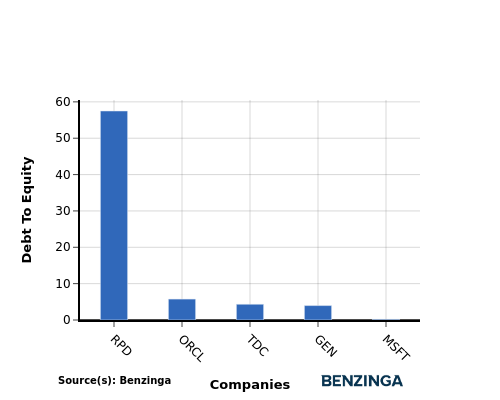In today's rapidly changing and fiercely competitive business landscape, it is vital for investors and industry enthusiasts to carefully evaluate companies. In this article, we will perform a comprehensive industry comparison, evaluating Microsoft MSFT against its key competitors in the Software industry. By analyzing important financial metrics, market position, and growth prospects, we aim to provide valuable insights for investors and shed light on company's performance within the industry.
Microsoft Background
Microsoft develops and licenses consumer and enterprise software. It is known for its Windows operating systems and Office productivity suite. The company is organized into three equally sized broad segments: productivity and business processes (legacy Microsoft Office, cloud-based Office 365, Exchange, SharePoint, Skype, LinkedIn, Dynamics), intelligence cloud (infrastructure- and platform-as-a-service offerings Azure, Windows Server OS, SQL Server), and more personal computing (Windows Client, Xbox, Bing search, display advertising, and Surface laptops, tablets, and desktops).
| Company | P/E | P/B | P/S | ROE | EBITDA (in billions) | Gross Profit (in billions) | Revenue Growth |
|---|---|---|---|---|---|---|---|
| Microsoft Corp | 31.47 | 9.59 | 11.15 | 8.17% | $36.79 | $47.83 | 12.27% |
| Oracle Corp | 34.22 | 24.44 | 7.47 | 19.27% | $5.89 | $9.94 | 6.4% |
| ServiceNow Inc | 121.01 | 17.79 | 15.71 | 4.06% | $0.62 | $2.33 | 21.34% |
| Palo Alto Networks Inc | 98.55 | 18.12 | 14.43 | 4.35% | $0.41 | $1.66 | 14.29% |
| Fortinet Inc | 44.04 | 51.24 | 12.90 | 43.82% | $0.66 | $1.35 | 17.31% |
| Gen Digital Inc | 26.81 | 7.84 | 4.40 | 7.48% | $0.45 | $0.79 | 4.01% |
| Monday.Com Ltd | 412.39 | 12.60 | 13.79 | 2.3% | $0.07 | $0.24 | 32.29% |
| Dolby Laboratories Inc | 30.23 | 3.14 | 6.04 | 2.72% | $0.11 | $0.32 | 13.13% |
| CommVault Systems Inc | 43.49 | 25.26 | 7.92 | 3.9% | $0.02 | $0.21 | 21.13% |
| Qualys Inc | 27.98 | 9.95 | 8 | 9.49% | $0.05 | $0.13 | 10.11% |
| SolarWinds Corp | 28.84 | 2.26 | 4.04 | 5.26% | $0.07 | $0.19 | 6.14% |
| Progress Software Corp | 34.75 | 5.25 | 3.16 | 0.27% | $0.05 | $0.18 | 21.47% |
| Teradata Corp | 20.36 | 16.80 | 1.33 | 19.38% | $0.06 | $0.24 | -10.5% |
| Rapid7 Inc | 71.78 | 103.70 | 2.15 | -25.97% | $0.02 | $0.15 | 5.36% |
| Average | 76.5 | 22.95 | 7.8 | 7.41% | $0.65 | $1.36 | 12.5% |
By closely studying Microsoft, we can observe the following trends:
-
The Price to Earnings ratio of 31.47 is 0.41x lower than the industry average, indicating potential undervaluation for the stock.
-
With a Price to Book ratio of 9.59, significantly falling below the industry average by 0.42x, it suggests undervaluation and the possibility of untapped growth prospects.
-
With a relatively high Price to Sales ratio of 11.15, which is 1.43x the industry average, the stock might be considered overvalued based on sales performance.
-
With a Return on Equity (ROE) of 8.17% that is 0.76% above the industry average, it appears that the company exhibits efficient use of equity to generate profits.
-
The Earnings Before Interest, Taxes, Depreciation, and Amortization (EBITDA) of $36.79 Billion is 56.6x above the industry average, highlighting stronger profitability and robust cash flow generation.
-
Compared to its industry, the company has higher gross profit of $47.83 Billion, which indicates 35.17x above the industry average, indicating stronger profitability and higher earnings from its core operations.
-
With a revenue growth of 12.27%, which is much lower than the industry average of 12.5%, the company is experiencing a notable slowdown in sales expansion.
Debt To Equity Ratio

The debt-to-equity (D/E) ratio gauges the extent to which a company has financed its operations through debt relative to equity.
Considering the debt-to-equity ratio in industry comparisons allows for a concise evaluation of a company's financial health and risk profile, aiding in informed decision-making.
By evaluating Microsoft against its top 4 peers in terms of the Debt-to-Equity ratio, the following observations arise:
-
In terms of the debt-to-equity ratio, Microsoft has a lower level of debt compared to its top 4 peers, indicating a stronger financial position.
-
This implies that the company relies less on debt financing and has a more favorable balance between debt and equity with a lower debt-to-equity ratio of 0.21.
Key Takeaways
For Microsoft in the Software industry, the PE and PB ratios suggest the stock is undervalued compared to peers, indicating potential for growth. However, the high PS ratio implies the stock may be overvalued based on revenue. On the other hand, the high ROE, EBITDA, and gross profit ratios indicate strong profitability and operational efficiency. The low revenue growth may be a concern for future performance compared to industry peers.
This article was generated by Benzinga's automated content engine and reviewed by an editor.
Edge Rankings
Price Trend
© 2025 Benzinga.com. Benzinga does not provide investment advice. All rights reserved.
Trade confidently with insights and alerts from analyst ratings, free reports and breaking news that affects the stocks you care about.